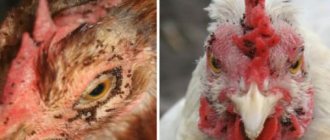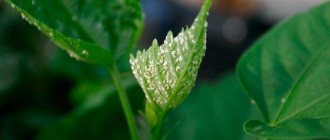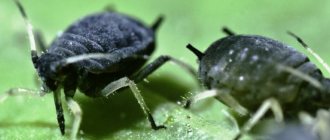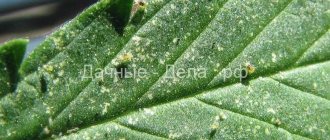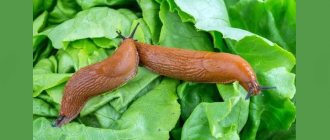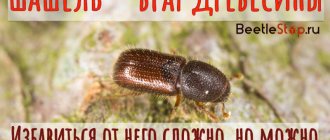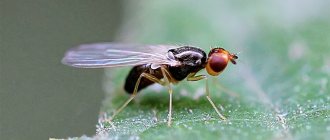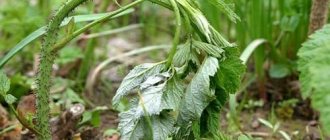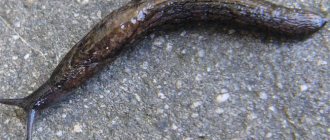Among the early berries that many people enjoy, cherries occupy a special place. Already in June, cherry trees look bright and elegant, thanks to the juicy dark red berries. Harvesting does not always go well if aphids appear on cherry leaves.
It is difficult to believe that insects from the group of Homoptera proboscis feeding on plant sap can settle on dense leaf plates. The small insect multiplies quickly and forms a real colony. Experts recommend how to get rid of aphids on cherries so that the berries are not damaged and the tree retains its strength for the next season.
Description of black aphids
Aphids are insects from the genus Hemiptera. Cherries, plums and other stone fruits are attacked by black aphids. These are small creatures that reach a size of no more than a couple of millimeters. The body shape of an insect is always different.
Aphids can be both wingless and winged. The wingless type of insect does not leave its habitat and constantly reproduces there. One individual insect can produce 4-5 generations of offspring within a couple of months. The number of individuals reaches several hundred thousand, which constantly reproduce. In summer, 10-12 generations can be born.
Aphids are attracted to cherries by their juice. They extract it from the plant by piercing the surface of the shoots with their proboscis. Aphids prefer the juiciest plants for food; it is easier to get food from them. Black aphids infect the bases of leaves and tops of shoots.
The winged subspecies spreads aphids to other plants. It is not born in every generation, but only when the colony becomes too large for one plant. Also, winged aphids appear during cold weather and other unfavorable conditions.
During feeding, aphids secrete sweet honeydew, which attracts other garden insects. Bees use honeydew to create honeydew honey. The main lovers of the sweet substance are ants. They become a kind of protectors of aphids. Ants protect aphids from other insects and transfer them to other plants.
Why is it dangerous for trees?
This family of insects is quite a nasty pest.
Settling on the underside of leaves, aphids suck juices from fresh green plants, destroying young shoots. At the same time, it secretes poison, which causes the leaves to curl, change shape and die, the shoots do not grow, and the tops become bent. Aphid waste - sweet secretions - contaminates the leaves, thereby disrupting the natural life of the plant. She also spreads viral infections through her saliva. Among fruit trees, the greatest damage occurs to young seedlings. Aphids are familiar small insects up to 7 mm. They have a special piercing-sucking proboscis, which they use to pierce the surface of leaves, buds or new shoots and suck out the juice. The plant is greatly weakened and becomes susceptible to viral diseases. Some species of aphids damage plant roots. Aphids come with wings and without wings. Some fly away with the wind up to 25 km, while others reproduce locally 2 times a year, in spring and summer. The excrement excreted by aphids contains a lot of carbohydrates; ants love this special treat. Ants carry aphid larvae over considerable distances to succulent parts of the plant, protecting them from bad weather even in their anthill. It is ants in symbiosis with larvae, winged and wingless representatives of aphids that can cause great trouble in your garden.
The insects adapted to seasonal changes and studied the physiology of the plant they liked. They reproduce in two ways: the first is natural mating of males and females, and the second method is viviparity of virgin females. Aphids are a dangerous insect and must be combated in spring and autumn. In the fall, females lay eggs that overwinter on trees and shrubs and hatch into wingless females.
Ants carry such wingless creatures from tree to tree. In May, winged females appear, capable of migrating over distances that will give birth to males and females in September. They are fertilized again and this process is endless, which once again proves the complexity of combating this type of pest.
The aphid's diet is enormous; it feeds on fruits on apple, pear, quince, plum, medlar, hawthorn, serviceberry and dogwood trees. It multiplies and therefore harms sunflower, thistle, chamomile, thistle, and comfrey. There are lovers of flower plants - roses, meadowsweet, tulips, black currants, viburnum. There are 450 species of aphids in our hemisphere.
Obviously, without taking special measures to destroy these pests, enormous damage will be caused to the garden and the entire area.
The fight against aphids is further complicated by their rapid reproduction.
In addition to methods of getting rid of aphids, which we will consider later in our article, you need to pay attention to preventive measures
Reasons for the appearance of black aphids on cherries
Before you fight aphids on cherries, you need to pay attention to the causes of tree infestation. The main reasons for cherry aphid infestation are:
• a large number of weeds around the tree; • colonies of ants living nearby; • weak plant immunity.
An unkempt garden with a lot of weeds will quickly lead to the appearance of various diseases. Winged aphids can reproduce on weeds in early spring, and then transfer their relatives to cherries in June, when cherries are in fruiting period.
Aphid colonies would not be able to develop quickly without the ants. The wingless aphid would be destroyed by other insects or would die from lack of food. Winged aphids reproduce poorly and would not be able to restore the colony. The wingless subspecies cannot move normally around the plant without ants.
Signs of pest damage
In addition to the deplorable condition of the leaves, there are several other consequences. Aphids on trees and other plants are visible to the naked eye. According to descriptions, the size of one individual does not exceed 8 mm in length. The aphid's body shape is oval. The color is almost always greenish, which is the best camouflage. Sometimes there are black, red or pink shades in color. A separate variety is the transparent aphid.
Damage from black aphids on cherries
The action of the pest leads to the following negative consequences:
• infestation by aphids can lead to the death of the tree; • plants have an increased chance of being infected by various viruses; • yields are significantly reduced; • berries become small and ugly; • the possibility of infection of all neighboring plants.
Black aphids can infect currants, gooseberries, raspberries and other neighboring plants. The insect can also harm plums, apricots and other stone fruits. The pest feeds on plant sap, which disrupts the flow of nutrients into the leaves. They dry out and curl, and the affected surface turns black.
There is a risk of getting infected from black aphids. Various fungal diseases can develop on the shoots. Along with insect saliva, various microorganisms enter the cells. Sooty fungus can lead to crop loss, and if the tree is not cured before winter, it will die.
cherry fly
Seemingly harmless flies can cause no less harm. The cherry fly, for example, is a dangerous pest of cherries, due to which you can lose almost the entire harvest. The larvae laid by insects feed on the fruits and spoil them. When the cherry falls to the ground, the grown insect goes to the surface layer of soil for the winter. Miner flies are no less dangerous. Cherry pests are detected by the passages in the leaves. Winding tunnels inside the leaf blades indicate that the eggs laid have turned into larvae, ready to emerge and become a new generation of adult insects by spring. In case of mass infection, the leaves suffer so much that the tree cannot properly prepare for winter, as a result it freezes, gets sick, and produces a smaller harvest.
How to deal with aphids on cherries
When black aphids appear on cherries, how to get rid of the pest must be decided as quickly as possible. An integrated approach to treatment will help to completely remove aphids and save cherries.
The fight against the parasite is carried out using the following methods:
• regular weeding of the soil to remove weeds; • destruction of cherry shoots; • timely application of fertilizing and fertilizers; • use of chemical and biological agents; • preventive treatment; • attracting insects to the cherry that feed on aphids.
Causes and symptoms of plant infection
The main reason for the appearance of a colony of pests in the garden is their need for certain amino acids. The family of black aphids belongs to the oliphagae, which obtain the necessary substances only from stone fruit trees, preferring cherries and cherries. The juice of these plants allows insects to maintain life and reproductive cycles, promoting rapid reproduction and settlement over a large area.
There are several symptoms by which you can determine that black aphids on cherries are spreading quickly. These include:
- discoloration, curling and falling of leaves before the leaf fall season;
- the appearance of gall formations on the leaves and bark of young branches.
Colonies always leave behind a sweet secretion (honeydew). The presence of sticky areas on the plant and scurrying ants are mandatory symptoms confirming the presence of cherry aphids.
Chemicals to control aphids
Among the most effective ways to treat cherries against aphids are the following:
• Karbofos; • Fufan; • Arrivo.
These are fast-acting contact agents. They penetrate the insect through the outer cover. This treatment leads to the death of parasites.
The fight against aphids on cherries is also carried out with intestinal and systemic drugs. These methods of control can quickly rid cherries of aphids. The substances enter the insect's body when it eats.
The following preparations will help remove aphids from leaves:
1. Aktara. The product is absorbed into the plant tissue, after which it is effective for 14 days. The active ingredient is thiametoscam. 2. Actedylic. The drug is an insecticide that contains pirimiphos-methyl. 3. Inta-vir. The active ingredient is cypermethrin. 4. Confidor. Insecticide containing imidacloprid. The duration of action of the drug is very long.
Treatment with pesticides should be carried out at least a month before picking berries. Preparations can be used at the beginning of summer or after flowering has ended; this can destroy aphids that have just attacked. It is important not to treat with insecticides during flowering, as this will lead to the death of bees. For prevention, you can apply the product 20 days before the flowers appear.
Cherry weevil
Small, golden-reddish beetles up to 5 mm long feed from early veins on cherry buds, young foliage and flowers. And such damage indicates a serious danger from pests, but weevils do not disdain filling fruits, eating away the indentations right down to the very pit. Here, cherry pests lay their eggs, and the hatching larvae continue to cause damage, destroying the core of the seed. Spoiled fruits fall off, and the larvae move from them to the ground, where they successfully pupate and wait for spring. In early spring, when the snow has melted but the buds have not yet awakened, cherry weevils can be manually shaken off onto improvised materials spread under the trees, collected and burned. This method is convenient if low-growing varieties grow in hell, but is completely unsuitable when the pest threatens large trees 5–7 meters high.
Therefore, a more competent and long-term way is to install fishing belts. They will protect the plantings not only immediately, but also throughout most of the summer.
When attacked by weevils, chemical means of protection, as well as traditional methods, are used. How to spray cherries against pests in this case? Modern insecticides, which are used to irrigate crowns, trunks and tree trunks, help against beetles. Treatment is carried out early, after flowering and in the fall, after leaf fall.
In addition, cherries can be treated with a daily infusion of fragrant or chamomile. A bucket of hot water will require 100 grams of plant material and half a bar of crushed laundry soap.
Biological agents to combat aphids
Aphids on leaves can be destroyed using insecticides that contain toxic substances of biological origin. Cherries are processed with the following preparations:
• Aktofit; • Phytofarm; • Nemabact; • Anthonem-F.
The first 2 products contain avermectins, which are products of fungal synthesis. Nemabact and Eetonema use predatory microorganisms that feed on parasite eggs.
You can control pests with biological means even during the growing season. The preparations are much weaker than chemical ones, which allows you to pick berries just a few days after use. Such preparations do not remain on the leaves for a long time and do not pose a danger to bees.
What medications will help?
The use of chemicals is the most effective way to get rid of pests. The drugs will help cope with even large colonies. The optimal time to treat wood with chemicals is early spring. You need to be in time before the buds open and flower. This way, the gardener can be sure that there will be no chemical residues left before the fruiting period, and the cherries can be safely enjoyed.
Among the pest control products there are new generation products. They do not harm the ovary and quickly disappear. This allows you to use them right before flowering. If possible, it is better to choose something from this line.
The most popular among experienced gardeners are the following three drugs with different spectrums of action:
- Spark. The product impresses with its versatility. It will help get rid of not only aphids, but also other harmful garden pests. The composition contains additional components: anti-stress additives, potassium. They help the tree recover quickly after a pest attack. The drug is available in tablet form. They are diluted with water strictly according to the instructions, and then sprayed.
- Commander. The drug is sold in ampoules. It must be diluted in water according to the scheme proposed by the manufacturer. The drug is able to cope with all existing garden pests, their larvae and even oviposition. The action of the product does not depend on weather conditions: temperature changes, rain, heat do not affect the active substances. The high efficiency of the product also has a disadvantage: after spraying, there are fewer beneficial insects, such as pollinators, in the garden. This affects productivity. To reduce the risks of this scenario, the procedure should be carried out in early spring.
- Fitoverm. The drug is obtained from the waste products of those microorganisms that can be found in the soil. The insectoacaricide disintegrates after a couple of days. The product is safe for the environment. The drug is available in ampoules. There is a mandatory condition for processing: only on a fine day.
Trees must be treated with any preparation either in the morning or in the evening. If you spray the garden on a hot day, there is a high probability of burns on the leaf plate. Pests have a unique ability to adapt to poisons. If treatment is required again next season, the drug should be changed.
Fruits from trees treated with chemicals must be washed thoroughly. Even if the procedure was carried out long before flowering, it is better not to risk it and not put the berry into your mouth directly from the branch.
Traditional methods of fighting aphids on cherries
To combat aphids, you can make various solutions yourself. Folk remedies for combating aphids should be positioned only as an auxiliary treatment. Treatment should be carried out using a comprehensive method.
One of the most popular means is soap solution. If you spray this liquid on a tree, the number of insects will be significantly reduced. To create the product you will need 200 g of crushed laundry soap, which must be diluted in 2 liters of water. To enhance the effect, you can add 100 g of ash. After complete dissolution, you need to spray the tree.
Aphids do not tolerate garlic well, so it is recommended to make an infusion from it. To create it, you need to chop the head of garlic and place it in water. The product should steep for 4-6 days, after which the infusion is filtered and diluted with water. For 5 liters you need 30 g of solution.
You can prepare a solution based on iodine. One bottle must be diluted in 1 liter of water. This solution can also be sprayed on currants, raspberries, strawberries, etc. For effectiveness, you can add a little milk to the liquid.
conclusions
Different varieties of cherries, such as Miracle, Shubinka, are attacked by many different pests. One of the insects that harm cherry trees is aphids. The most effective methods of combating it are chemical agents:
- Carbolinium solution.
- DNOC.
- Metaphos.
- Karbofos.
- Anabasine sulfate, nicotine sulfate and others.
Biological methods of controlling aphids are also often used. Beneficial insects that eat harmful ones help with this:
- Sunny (five-spotted ladybug).
- Lacewing.
- Trichogramma.
To ensure that the products in the garden are environmentally friendly, gardeners often use various folk remedies to destroy and prevent the appearance of aphids on cherry trees.
Sources
- https://DachaMechty.ru/vishnya/14-tlya-kak-izbavitsya.html
- https://tlia.ru/kak-borotsya-s-tlyoj-na-vishne/
- https://babushkinadacha.ru/bolezni-i-vrediteli/vrediteli-chereshni-i-vishni-mery-borby-s-nimi.html
- https://KomnatnieCveti.ru/yagody/vishnevaya-tlya-2.html
- https://glav-dacha.ru/kak-izbavitsya-ot-tli-na-vishne/
- https://KinzaRostov.ru/yagody/vishnevaya-tlya-2.html
- https://fermilon.ru/sad-i-ogorod/vrediteli/tlya-na-vishne-narodnye-sredstva-i-preparaty-dlya-borby-s-vreditelem.html
- https://PchelkinaStrana.ru/sad/chernaya-tlya-na-vishne.html
- https://PoFerme.com/sad/derevya/vishni/bol-vish/sposoby-borby-s-tlej.html
[collapse]
Using food to control aphids on cherries
You can fight aphids on cherries with Coca-Cola. This drink contains phosphoric acid, which kills pests. The cola should be diluted with water in a ratio of 1 to 1 and the solution should be sprayed on the affected tree.
Baking soda can kill aphids. It is necessary to dissolve 10 g of soda in 1 liter of water and treat the cherries. This method is effective at any stage of infection.
To combat parasites I use dry mustard. For 1 liter of water you need to take 100 g of mustard in powder form and mix everything. Both aphids and ants dislike the mustard scent. After treatment, they begin to quickly leave the plant. To enhance the effect, you can add a little liquid soap to the solution.
Plum tree disease red spot
The description of this disease of plums is similar to the description of red spot in all other stone fruit trees. The main signs of this plum leaf disease are yellowish or light red spots on both sides of the leaf. As the disease progresses, the spots thicken and become bright red and shiny. The spots on fallen leaves darken.
Trees affected by this disease weaken and their winter hardiness decreases. Flowers and ovaries often fall off.
Below are photos of this plum disease and methods of combating the disease:
To combat red spot, trees and soil are recommended to be generously sprayed with a solution of copper sulfate. This procedure should be carried out before the buds open.
Immediately after plum blossoms, you can spray the trees with a 1% solution of Bordeaux mixture (100 g per 10 liters of water). If the disease spreads strongly, the procedure should be repeated 2-3 weeks after flowering.
It is necessary to promptly remove all fallen leaves under garden trees and dig up the soil in the tree trunk circle, since this is where fungal spores overwinter.
It is recommended to choose plum and cherry plum varieties that are resistant to this disease.
Content
- Common diseases of cherries and cherries
- PREVENTIVE protection of cherries from diseases
- TREATING cherries for diseases
- Application of FUNGCIDES for preventive and therapeutic treatments of cherries against diseases
- a) COPPER-CONTAINING preparations
- b) IODINE-CONTAINING preparations
- c) SALT-CONTAINING preparations
- d) MULTI-COMPONENT and SYSTEMIC FUNGICIDES
- As a conclusion
Treatment of cherries for diseases involves two directions - preventive protection (containing the spread of phytopathogens, preventing infection, etc.) and the actual treatment itself (the disease is detected by characteristic signs and progresses).
